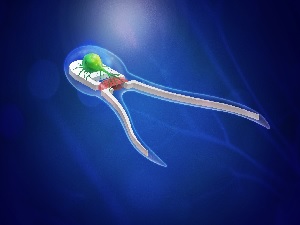



Date:18/09/19
 Tiny, soft robots that can safely navigate biological settings like the human body could mean big things for medical treatment, but moving them through these environments is much easier said than done. Scientists at the University of Illinois have come up with a promising new possibility, describing biohybrid robots that can be propelled purely by a mix of motor neurons, muscular tissue and light.
Tiny, soft robots that can safely navigate biological settings like the human body could mean big things for medical treatment, but moving them through these environments is much easier said than done. Scientists at the University of Illinois have come up with a promising new possibility, describing biohybrid robots that can be propelled purely by a mix of motor neurons, muscular tissue and light.
The team at the University of Illinois has been exploring these possibilities for quite some time. The same scientists have published a number of papers this decade describing synthetic bio-bots that use integrated cardiac cells that beat and light to drive propulsion systems, allowing them to walk and swim on their own.
“Our first swimmer study successfully demonstrated that the bots, modeled after sperm cells, could in fact swim," says mechanical science and engineering professor Taher Saif. “That generation of singled-tailed bots utilized cardiac tissue that beats on its own, but they could not sense the environment or make any decisions.”
Continuing their work in pursuit of these capabilities, the team has a new design that features two tails instead of one. The biobots consist of a soft scaffold layered with skeletal muscle tissue and light-responsive motor neurons sourced from mouse stem cells. When exposed to light, the neurons fire and become actuators that kick the muscle tissue into gear and propel the robot forward.
Using muscle tissue to power biobots was a hallmark of the team’s earlier work and makes a lot of sense. It is entirely biodegradable and can expand and contract without the need for external batteries or power. Previous versions used electrical signals to trigger this process, and using neurons in their place has been a long-time goal for the team hoping to turn them into “intelligent machines.”
“Here, we achieve this milestone and demonstrate neuromuscular actuation of a biohybrid swimmer,” the team writes in their paper. “This paves the way for the development of biohybrid embodied platforms as models to gain deeper understanding of motor control, with potentially broad impact in robotics, bioengineering, and health.”
The research was published in the journal Proceedings of the National Academy of Sciences.
Biobots made from muscle propelled by neurons and light
 Tiny, soft robots that can safely navigate biological settings like the human body could mean big things for medical treatment, but moving them through these environments is much easier said than done. Scientists at the University of Illinois have come up with a promising new possibility, describing biohybrid robots that can be propelled purely by a mix of motor neurons, muscular tissue and light.
Tiny, soft robots that can safely navigate biological settings like the human body could mean big things for medical treatment, but moving them through these environments is much easier said than done. Scientists at the University of Illinois have come up with a promising new possibility, describing biohybrid robots that can be propelled purely by a mix of motor neurons, muscular tissue and light.The team at the University of Illinois has been exploring these possibilities for quite some time. The same scientists have published a number of papers this decade describing synthetic bio-bots that use integrated cardiac cells that beat and light to drive propulsion systems, allowing them to walk and swim on their own.
“Our first swimmer study successfully demonstrated that the bots, modeled after sperm cells, could in fact swim," says mechanical science and engineering professor Taher Saif. “That generation of singled-tailed bots utilized cardiac tissue that beats on its own, but they could not sense the environment or make any decisions.”
Continuing their work in pursuit of these capabilities, the team has a new design that features two tails instead of one. The biobots consist of a soft scaffold layered with skeletal muscle tissue and light-responsive motor neurons sourced from mouse stem cells. When exposed to light, the neurons fire and become actuators that kick the muscle tissue into gear and propel the robot forward.
Using muscle tissue to power biobots was a hallmark of the team’s earlier work and makes a lot of sense. It is entirely biodegradable and can expand and contract without the need for external batteries or power. Previous versions used electrical signals to trigger this process, and using neurons in their place has been a long-time goal for the team hoping to turn them into “intelligent machines.”
“Here, we achieve this milestone and demonstrate neuromuscular actuation of a biohybrid swimmer,” the team writes in their paper. “This paves the way for the development of biohybrid embodied platforms as models to gain deeper understanding of motor control, with potentially broad impact in robotics, bioengineering, and health.”
The research was published in the journal Proceedings of the National Academy of Sciences.
Views: 682
©ictnews.az. All rights reserved.Similar news
- The mobile sector continues its lead
- Facebook counted 600 million active users
- Cell phone testing laboratory is planned to be built in Azerbaijan
- Tablets and riders outfitted quickly with 3G/4G modems
- The number of digital TV channels will double to 24 units
- Tax proposal in China gets massive online feedback
- Malaysia to implement biometric system at all entry points
- Korea to build Green Technology Centre
- Cisco Poised to Help China Keep an Eye on Its Citizens
- 3G speed in Azerbaijan is higher than in UK
- Government of Canada Announces Investment in Green Innovation for Canada
- Electric cars in Azerbaijan
- Dominican Republic Govt Issues Cashless Benefits
- Spain raises €1.65bn from spectrum auction
- Camden Council boosts mobile security





















